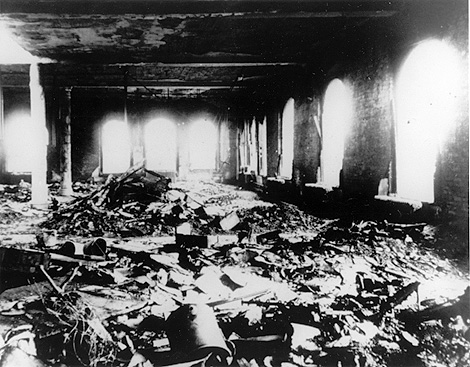HOLLYWOOD—On March 25, 1911, a catastrophic fire broke out at the Triangle Waist Company in New York City. Trapped inside the upper floors of a 10-story building, 146 workers—mostly young immigrant women and teenage girls—were burned alive or forced to jump to their deaths to escape an inferno that consumed the factory in just 18 minutes. It was the worst workplace disaster in New York State until 9/11.
The tragedy changed the course of history, paving the way for government to represent working people, not just business, for the first time, and helped an emerging American middle class to live the American Dream.
Emmy®-winning filmmakers Marc Levin and Daphne Pinkerson (the 2009 HBO documentary “Schmatta: Rags to Riches to Rags” and 1999’s “Thug Life in D.C.”) bring the victims’ stories to life through never-before-seen photographs and heartfelt accounts by descendants of those who were there that day. While people have seen the horrendous images of burnt corpses on the street outside the building, this film gives them back their humanity.
The people of New York City already knew these girls from 1909’s uprising of the 20,000, when shirtwaist workers, most of them recent immigrants from Eastern Europe, went on strike demanding higher pay, shorter hours and better conditions. An event in American history missing from most textbooks, it was the first great uprising of women ”“ at a time when they didn’t have the vote.
Organized by the newly created International Ladies Garment Workers Union (ILGWU), the workers had marched in the streets, stood on picket lines and been beaten by hired thugs. When many of them later appeared on the ledges of the burning Asch Building, without any chance of survival, it broke the hearts of New Yorkers who remembered their pleas.
Worst of all, the fire was preventable. Safety precautions such as sprinklers and fire drills existed at the time, but were not required by government regulations, which would have cost businesses money.
“Triangle: Remembering The Fire” is inspired by Celia Gitlin, a 17-year-old Russian immigrant who perished in the fire, and was the great aunt of Sheila Nevins, president of HBO Documentary Films and the film’s executive producer. Nevins had long suspected that her grandmother’s younger sister died in the fire. While filming “Schmatta: Rags to Riches to Rags,” the producers located Gitlin’s death certificate and confirmed the fact.
As public outrage grew after the fire, the city responded quickly to demands for change in the workplace and Tammany Hall officials worked with the fledgling ILGWU to enact legislation improving safety, conditions and wages for garment workers, serving as the foundation of today’s labor standards.
Interviewees, including many victims’ descendants, include: Susan Harris, granddaughter of Triangle co-owner Max Blanck, who says, “From a personal point of view, I’m happy my grandfather didn’t have to go to jail. From the victims’ and families’ point of view, if my daughter had died in the fire and he hadn’t been my grandfather, I probably would have shot him.”
Alfred E. Smith IV is the great-grandson of Democratic New York governor Alfred E. Smith, who ran for president in 1928 against Herbert Hoover. Moved by the tragedy, and cognizant of a rising tide of socialism, he was instrumental in getting Tammany Hall to represent working people.
Leigh Benin, a professor of labor history at Adelphi University, notes, “People forget the Triangle fire at their peril”¦If people want to know what deregulated industry would look like, look at the bodies on the sidewalk outside the Triangle building.” His cousin, 19-year-old Rosie Oringer, jumped from the building.
Suzanne Pred Bass’s great-aunt, Rosie Weiner, died in the fire. Rosie’s sister, Katie, survived and served as a witness for the state at the subsequent manslaughter trial. She offered a dramatic testimony, supporting the prosecution’s contention that the Washington Place door on the ninth floor of the factory was locked.
Katharine Weber is the author of the critically acclaimed novel “Triangle.” Her grandmother had worked at Triangle since the uprising of the 20,000 in 1909. She describes the working conditions, recounting her grandmother’s dramatic confrontation with police.
Erica Lansner is the grandniece of beloved forelady Fannie Lansner, 21, who was credited with saving numerous lives. Fannie Lansner ushered many workers off the floor but was killed in the fire.
Ray Ott’s grandfather, Andrew Ott, was one of the first firefighters to respond that day. Also a firefighter, Ray Ott witnessed similar horror on 9/11.
Bruce Raynor is the president of Workers United/SEIU (descendant union of the ILGWU), which fights for the rights of working people and lobbies for government oversight of industry. He compares the Triangle fire to the recent mining disaster and the Gulf oil-rig explosion.
An HBO On Demand exclusive, “Triangle: The Unidentified,” tells the story of the last remaining victims to be acknowledged. Of the 146 victims, six were burned beyond recognition. Their identities were lost in history until co-producer and historian Michael Hirsch used genealogical investigative techniques to reveal their identities. For the first time, and as a result of Hirsch’s research, the full list of the victims’ names is revealed in “Triangle: The Unidentified.” Each year the tragedy is commemorated, and on March 25, 2011, the 100th anniversary will be marked by citywide events.
Partners in Blowback Productions, Marc Levin and Daphne Pinkerson have made 11 previous documentaries for HBO, including “Mob Stories,” “Prisoners of the War on Drugs,” “Execution Machine: Texas Death Row,” “Soldiers in the Army of God,” “Gladiator Days: Anatomy of a Prison Murder,” “Schmatta: Rags to Riches to Rags,” “Thug Life in D.C.,” which won the 1999 Emmy® for Outstanding Non-Fiction Special and “Gang War: Bangin’ in Little Rock,” which won the 1994 CableACE Award for Best Documentary Special. Levin’s 1998 feature film “Slam” won the Grand Jury Prize at Sundance.
“Triangle: Remembering The Fire” was directed by Daphne Pinkerson; produced by Daphne Pinkerson and Marc Levin; written by Michael Hirsch, Richard Lowe and Daphne Pinkerson; scenes from “The Triangle Factory Fire Scandal” directed by Mel Stuart. For HBO: senior producer, Nancy Abraham; executive producer, Sheila Nevins.
The HBO documentary “Triangle: Remembering The Fire” tells an historic story that is still relevant today when it debuts Monday, March 21 (9-9:45 p.m. ET/PT), exclusively on HBO.
Photographs are Courtesy: HBO Productions






